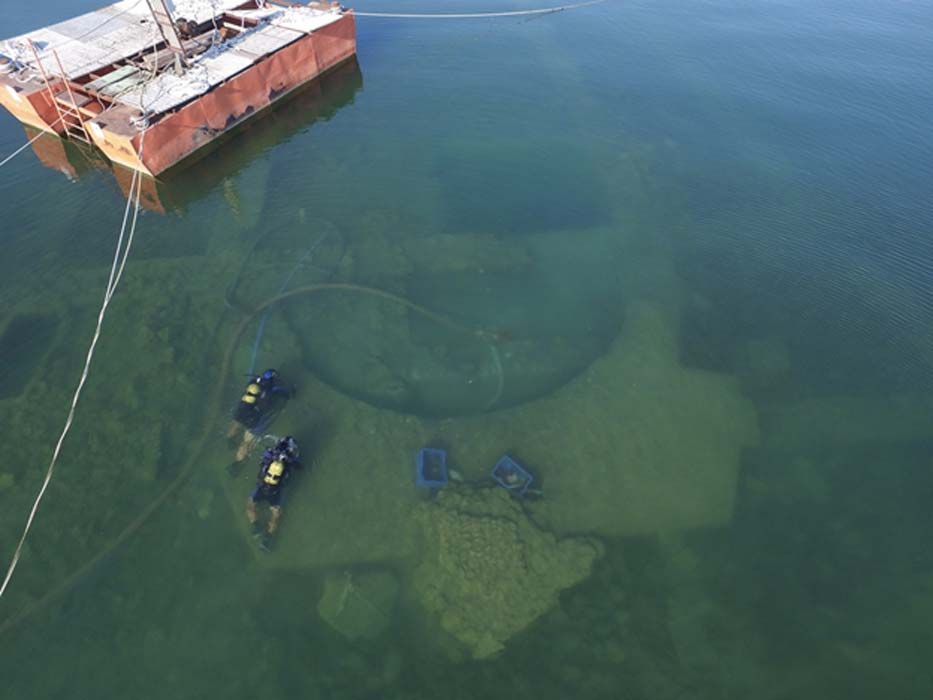Christian Basilica, and now Possibly a Roman Pagan Temple Found in a Turkish Lake
The foundations of a massive submerged ancient church in Turkey are suspected to have been built on top of an even greater treasure, an older Roman pagan temple dedicated to the sun god Apollo.
Mustafa Şahin, the head of archaeology at Bursa Uludağ University, had been searching the shores of Lake Iznik in Turkey for several years for the ruins of the ancient holy building, and when local government surveyors showed him aerial photographs taken in 2014 he knew immediately that the lake had been covering the ancient ruins. A 740 AD earthquake destroyed the church and its ruins sank beneath the lake's surface where they remained undisturbed for the last 1300 years.
Discovery of the Basilica
When Sahin first saw the photographs of the submerged ancient church he told reporters he “couldn't quite believe what he was seeing,” according to a report in Live Science. The submerged holy building is in Lake Iznik near the western tip of Turkey, about a 2-hour drive from the capital of Istanbul. It is about 10 feet (3 meters) deep and about 160 feet (50 m) from the shore.

The submerged holy building has been found in Lake Iznik in Turkey. (Image: Mustafa Şahin/Lake Iznik Excavation Archive)
Sahin and his team of specialists from Iznik’s Archaeology Museum have been carrying-out underwater excavations of the submerged basilica since 2015 but the hot climate means the lake is filled with algae, reducing diver’s visibility to a few inches, Şahin said. The archaeologists used vacuums to carry silt from the excavation to the shore, where it has been sifted for artifacts.
Several human graves were discovered beneath the basilica's main transverse wall containing coins, some dating to the time of Valentinian II (who ruled from AD 375 to 392), telling archaeologists that the Roman-style church, known as a basilica, must have been built sometime around AD 390, when Iznik was known as Nicaea.
- Archaeologists find evidence of devastating ancient earthquake in mountaintop city of Hippos
- Who Was Mithra? Sanctuary for a Mysterious Cult that Once Rivaled Christianity is Found on Corsica
- Who is Buried in the Famous Shrine of St James in Santiago de Compostela?

The underwater Byzantine Basilica. ( Kenyon College )
Şahin told Live Science by email that he believes that the basilica was dedicated to St. Neophytos, an early Christian martyr, who the Romans killed in died in Nicaea in 303 AD during the reign of the emperor Diocletian. Nicaea itself became a famous city throughout the Christian world after 325 AD when Constantine convened the first council of church leaders there to determine the new religion, according to an earlier Live Science article.
Hidden Depths of Pagans
But as grand as this discovery is, it might only be the tip of an archaeological iceberg because scientists predict that the basilica may have been built over an earlier pagan temple. Early coins and fragments of an ancient lamp were discovered at the church which hinted at the presence of an even earlier structure and Şahin asked, "Could this temple have been underneath the basilica remains?”
Sahin’s research leads him to conclude that the church was most likely built on top of a pagan temple to the Greek and Roman sun god Apollo, because Roman records informed him that Roman emperor Commodus, who ruled from 180 to 192 AD “built a temple to Apollo at Nicaea outside the city fortifications.” At the entrance to the popular Aegean resort of Didim in Turkey lie the ruins of another Temple of Apollo.
- First Ancient Oracle Well to Apollo unearthed in Athens
- Lost Temple of Apollo Unearthed by Archaeologists
- Celestial Goddess Selene: The Star of the Night

Coins from the reign of Emperor Antoninus Pius (AD 138-161) recovered from the site. (Mustafa Şahin/Lake Iznik Excavation Archive)
Apollo was famous for his healing abilities and the temple at Didim was a popular sanctuary and office of one of the most famous oracles in the world - the high priestess of the temple of Didim - who people travelled from hundreds of miles away to consult. Generally poor people couldn’t afford the sacrifices required, leaving only the wealthy to take advantage of future predictions.
Whether a pagan temple is discovered or not, big plans for an underwater museum have been submitted which would not only include a 60-foot-high (20 m) viewing tower on the shore, but an extended walkway will take tourists right over the submerged church.
The museum will include a diving club and an underwater glass-walled environment located in the ancient nave of the submerged basilica where visitors could pray, Şahin said. If the plans are passed this month, Sahin believes the museum construction project could begin as soon as the end of next year.
Top image: The ruined Christian church in Turkey's Lake Iznik is thought to have been built over a Roman Pagan temple Source: Mustafa Şahin/Lake Iznik Excavation Archive
By Ashley Cowie




















Comments
prefiro o templo